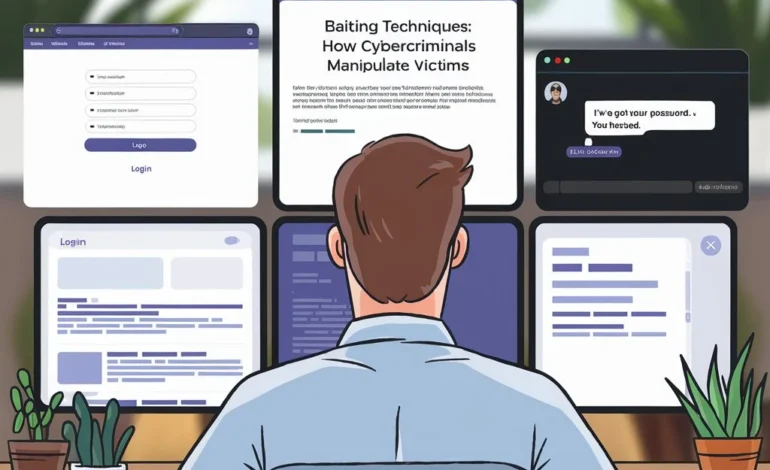Baiting Techniques: How Cybercriminals Manipulate Victims

Baiting is one of those especially insidious tricks in cybersecurity whereby cybercriminals manipulate victims into compromising their security. It is built on human psychology, using the fingers of curiosity and greed to lure into traps that compromise data, infect malware, and steal identities. Understanding what baiting is and the different methods employed will help individuals and organizations protect themselves from these malicious attacks.
What is Baiting?
Baiting is a form of social engineering in which attackers tempt victims with a reward or advantage, making them highly vulnerable to malicious content. Unlike phishing attacks that rely on urgency or fear, baiting involves offering something too good to resist. For example, the normal bait would say that in an email, one has won something or may download certain paid software for free. The moment the target bites and clicks a link or downloads any such file, they would probably install malware on their computer without knowing it or leak any personal information.
Types of Bait within the Cyber Space
There are various types of baits cybercriminals use to conduct their operations. Some of these include:
Email baiting involves emails that offer free downloads, special offers, and other such temptations. Sometimes, these emails also contain links to phantom websites aimed at stealing critical personal data or planting malware in the system of the victim. An appropriate email filtering system can ensure the detection and blocking of such emails long before they reach an inbox.
- USB Baiting: The attacker leaves infected USB drives in public places where someone may find and plug them into his or her computer. Once plugged into the computer, the USB can self-install malware. Once the malware has infected the victim’s system, it can easily spread throughout an organization’s network.
- Baiting File Sharing: Here, attackers create fake sites for file sharing; these would promise free movies, music, or any software. Users downloading files from such websites inadvertently install malware on their devices.
- Baiting through Fake Website: The attacker will create a fake website that looks like your personal legitimate website to attract its users to fill in information that could be sensitive, passwords, or credit card numbers. They use similar links and branding that will make users trust them.
- Social Media Baiting: Social media sites tend to be a primary target for baiting attacks. Some cybercriminals build and publish phony profiles or pages offering free products or services to elicit personal information from sharing or clicking on supplied links.
Why Baiting is Effective
Baiting manipulates two essentially basic parts of human psychology: curiosity and greed. People can’t resist an offer that appears to be a good deal or an exclusive offer because they want to learn more about what the offer includes. One may come across an email that reads, “You won a prize with a very high value” and feel obliged to click on the link without verifying the legitimacy of it.
In addition to that, baiting attacks can be very customized. Attackers usually do some homework on their victims through social media as well as other web-based sources to then devise messages that would make more sense either for a particular person or organization. This personalization makes the chances of success even higher since it encourages the victims to trust communications that relate to their interests or situations.
Mitigating Baiting Attacks
To counter baiting attacks, individuals and organizations should establish complex security measures including the following:
- Security Awareness Training: This is training the employees on the risks associated with baiting and other cyber threats. This way, the employees can easily identify fake emails, links, and requests for divulging information. Yearly training can achieve this by exposing employees to the signs of malicious activity.
- Endpoint Protection: Putting in place enhanced endpoint protection solutions to spot and block such activities before they attain the systems. This includes measures like antivirus software, firewalls, and intrusion detection systems installed on the organizational system.
- E-mail filtering: Implementation of proper e-mail filtering solutions will effectively minimize the risk of becoming a victim of baiting through mechanisms capable of detecting and blocking phishing e-mails even before they reach the users’ inboxes.
- Regular Software Updates: Keeping software and systems updated is very important to avoid vulnerabilities that attackers might exploit during baiting.
- Discouraging Caution: Remind users to check, through official channels, any unsolicited offer or request for personal information before they enter into any type of transaction. When something is too good to be true, it probably is.
Conclusion
Baiting is a serious threat in the cybersecurity world, since it tries to manipulate its victim with very appealing offers, while it can also seize advantage of human psychology eventually. That is why it is useful to learn what baiting is and what forms it may take, including email baiting, USB baiting, and social media baiting-things individuals can try to protect themselves from such tricks.
The awareness would thus help them employ effective prevention strategies that include security awareness training, endpoint protection, and email filtering, making them more capable of recognizing a threat before they can be victimized. With the advancement in technology, there is an emergent need to learn about emerging threats that might place personal and organizational data in pervasive risks of baiting that exist today.









